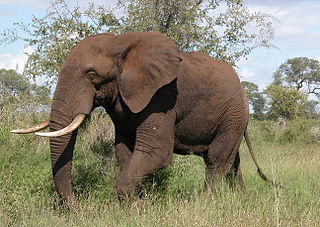
The Proboscidea are a taxonomic order of afrotherian mammals containing one living family (Elephantidae) and several extinct families. First described by J. Illiger in 1811, it encompasses the elephants and their close relatives. From the mid-Miocene onwards, most proboscideans were very large. The largest land mammal of all time may have been a proboscidean; Palaeoloxodon namadicus was up to 5.2 m (17.1 ft) at the shoulder and may have weighed up to 22 t, almost double the weight of some sauropods like Diplodocus carnegii. The largest extant proboscidean is the African bush elephant, with a record of size of 4 m (13.1 ft) at the shoulder and 10.4 t. In addition to their enormous size, later proboscideans are distinguished by tusks and long, muscular trunks, which were less developed or absent in early proboscideans.

A mastodon is any proboscidean belonging to the extinct genus Mammut. Mastodons inhabited North and Central America during the late Miocene or late Pliocene up to their extinction at the end of the Pleistocene 10,000 to 11,000 years ago. They lived in herds and were predominantly forest-dwelling animals. They generally had a browsing diet, distinct from that of the contemporary Columbian mammoth, which tended towards grazing.

Deinotherium was a large elephant-like proboscidean that appeared in the Middle Miocene and survived until the Early Pleistocene. Although superficially resembling modern elephants, they had notably more flexible necks, limbs adapted to a more cursorial lifestyle as well as tusks that curved downwards and back. In addition, their tusks didn't emerge from the maxilla as in elephants but from the mandible. Deinotherium was a widespread genus, ranging from East Africa to the south to Europe and east to the Indian Subcontinent. They were browsing animals with a diet mainly consisting of leaves, and they most likely died out as forested areas were gradually replaced by open grassland during the latter half of the Neogene.
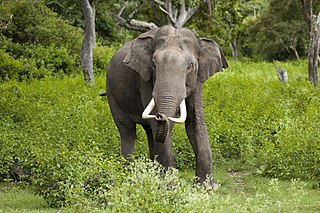
Elephantidae is a family of large, herbivorous proboscidean mammals collectively called elephants and mammoths. These are terrestrial large mammals with a snout modified into a trunk and teeth modified into tusks. Most genera and species in the family are extinct. Only two genera, Loxodonta and Elephas, are living.

Moeritherium is an extinct genus of primitive proboscideans. These prehistoric mammals are related to the elephant and, more distantly, sea cows and hyraxes. They lived during the Eocene epoch.

Gomphotheres are any members of the diverse, extinct taxonomic family Gomphotheriidae. Gomphotheres were elephant-like proboscideans, but do not belong to the family Elephantidae. They were widespread across Afro-Eurasia and North America during the Miocene and Pliocene epochs and dispersed into South America during the Pleistocene following the Great American Interchange. Gomphotheriidae in its broadest sense is probably paraphyletic with respect to Elephantidae, which contains modern elephants. While most famous forms such as Gomphotherium had long lower jaws with tusks, which is the ancestral condition for the group, after these forms became extinct, the surviving gomphotheres had short jaws with either vestigial or no lower tusks (brevirostrine), looking very similar to modern elephants, an example of parallel evolution. By the end of the Early Pleistocene, gomphotheres became extinct in Afro-Eurasia, with the last two genera, Cuvieronius persisting in southern North America and Notiomastodon having a wide range over most of South America until the end of the Pleistocene, when they became extinct following the arrival of humans.
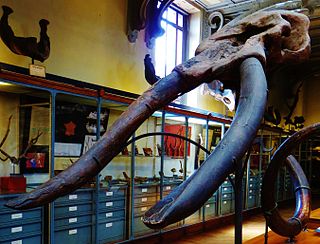
Cuvieronius is an extinct New World genus of gomphothere, named after the French naturalist Georges Cuvier. Alive, specimens typically stood about 2.3 m tall at the shoulder, weighed about 3.5 t and would have superficially resembled a modern elephant with spiral-shaped tusks.

Stegomastodon is an extinct genus of gomphotheres, a family of proboscideans. It ranged throughout North America from the early Blancan ~4 Ma, to the early Irvingtonian. The South American species have been synonymized with Notiomastodon platensis.

Daouitherium is an extinct genus of early proboscideans that lived during the early Eocene some 55 million years ago in North Africa.

Numidotherium is an extinct genus of early proboscideans, discovered in 1984, that lived during the middle Eocene of North Africa some 46 million years ago. It was about 90-100 cm tall at the shoulder and weighed about 250-300 kg.

Phosphatherium escuillei is a basal proboscidean that lived from the Late Paleocene to the early stages of the Ypresian age until the early Thanetian some 56 million years ago in North Africa. Research has suggested that Phosphatherium existed during the Eocene period.

Palaeoloxodon namadicus or the Asian straight-tusked elephant, is an extinct species of prehistoric elephant known from the early Middle to Late Pleistocene of the Indian subcontinent, and possibly also elsewhere in Asia.

Stegotetrabelodon is an extinct genus of primitive elephantid with gomphothere-like anatomical features from the Late Miocene to Early Pliocene of Africa and Eurasia and the Arabian peninsula. The type species is S. syrticus of late Miocene Africa, which reached roughly 4 m (13.1 ft) in shoulder height and 11–12 tonnes in weight. The other unequivocally recognized species is S. orbus, also of late Miocene Africa. Other species outside of Africa are questionably placed in this genus, including teeth from Late Miocene Hungary and Iran originally described as being of the Mastodon subgenus Bunolophodon, Chinese specimens originally described as being also of Mastodon, as well as of Tetralophodon and Stegodon, and a species from the late Miocene-aged Dhok Pathan Formation in Pakistan, S. maluvalensis.

Archaeobelodon is an extinct genus of proboscidean of the family Amebelodontidae that lived in Europe and North Africa (Egypt) during the Miocene from 16.9 to 16.0 Ma, living for approximately 0.9 million years.

Notiomastodon is an extinct proboscidean genus of gomphotheres endemic to South America from the Pleistocene to the beginning of the Holocene. Notiomastodon specimens reached a size similar to that of the modern Asian elephant. Like other brevirostrine gomphotheres such as Cuvieronius and Stegomastodon, Notiomastodon was characterized by its short snout and tall, highly arched skull. The short jaw was due to the loss of the lower tusks found in more primitive gomphotheres.

Stegodontidae is an extinct family of proboscideans from Africa and Asia from the Miocene (15.97 mya) to the Late Pleistocene, with some studies suggesting that some survived into the Holocene in China, although this is disputed. It contains two genera, the earlier Stegolophodon, known from the Early Miocene of Asia and the later Stegodon, from the Late Miocene to Late Pleistocene of Africa and Asia which derived from the former. The group is noted for their plate-like lophs on their teeth, which are similar to elephants and different from those than of other extinct proboscideans like gomphotheres and mastodons. This similarity with modern elephants may have been convergently evolved, however.
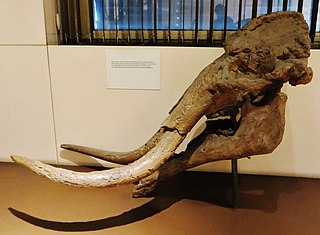
Choerolophodon is an extinct genus of proboscidean that lived during the Miocene of Eurasia and Africa. Fossils of Choerolophodon have been found in Africa, Southeast Europe, Turkey, Iraq, Iran, the Indian subcontinent, and China. Choerolophodon has a single pair of tusks growing from the upper jaw, which are long and strongly curved.
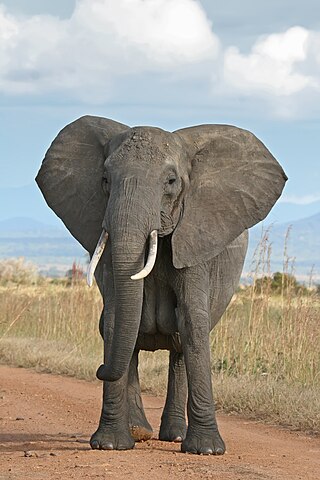
Elephantinae is a subfamily of mammals in the family Elephantidae and includes the largest existing land animals. Three species are currently recognised: the African bush elephant, the African forest elephant, and the Asian elephant. Elephantidae is the only surviving family of the order Proboscidea; extinct members include the mastodons. The family Elephantidae also contains several now-extinct groups, including the mammoths and straight-tusked elephants. African elephants have larger ears and concave backs, whereas Asian elephants have smaller ears, and convex or level backs. Distinctive features of all elephants include a long trunk, tusks, large ear flaps, massive legs, and tough but sensitive skin. The trunk, also called a proboscis, is used for breathing, bringing food and water to the mouth, and grasping objects. Tusks, which are derived from the incisor teeth, serve both as weapons and as tools for moving objects and digging. The large ear flaps assist in maintaining a constant body temperature as well as in communication. The pillar-like legs carry their great weight.
Protanancus is an extinct genus of amebelodontid proboscidean from Kenya, Pakistan and Thailand. The genus consists solely of type species P. macinnesi. The generic name is derived from the unrelated Anancus, and the Greek prōtos "first".
Dagbatitherium is an extinct genus of proboscideans. So far a single molar from the phosphate basins of Togo in West Africa has been found. The fossil dates to the Middle Eocene, around 47 million years ago. A striking feature of the tooth are the three pairs of cusps oriented transversely to the longitudinal axis of the tooth. This feature is found in more derived proboscideans, which are grouped in the Elephantiformes. For its age, Dagbatitherium is the earliest member of Elephantiformes to date. Furthermore, it is characterized by a low tooth crown and a humped occlusal pattern. The genus was described in 2021.




















